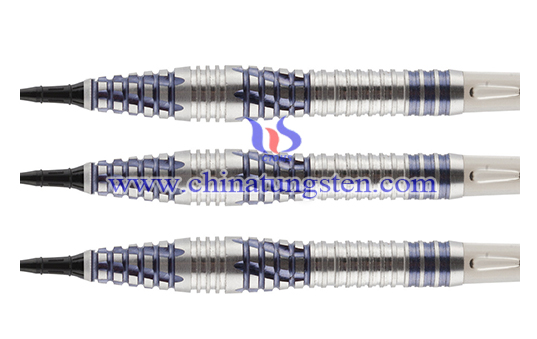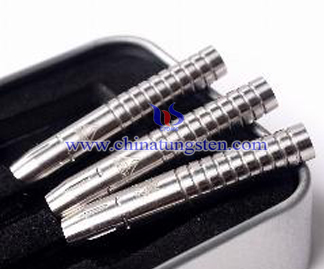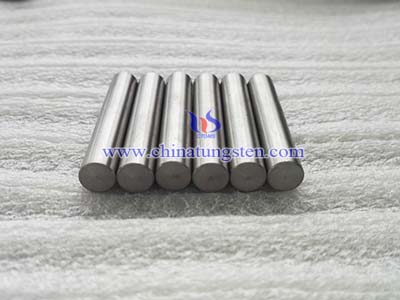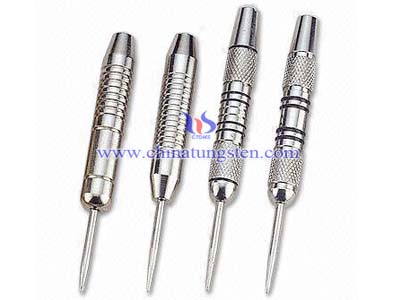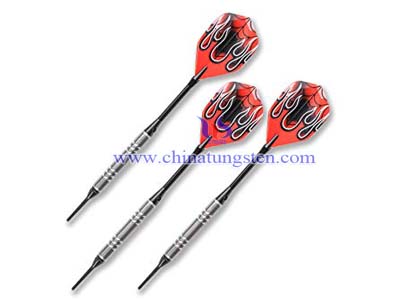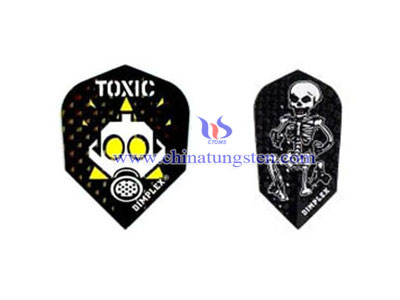Barrel forms the main part of dart. Nowadays, dart barrels made of tungsten are more and more popular all over the world, and we supply various tungsten dart barrels as per our clients’ specific sample or design.
Barrel shape
The barrel forms the main part of a dart. When we are speaking of "buying a (new) dart" we mean getting a new dart barrel. Nowadays barrels are available in almost every possible shape, with a wide selection of tungsten barrel knurl or rings on the surface for a comfortable and safe grip.
The main tungsten dart Barrels' Shapes are:
- cylinder
- ton
- torpedo
Some Barrel Shapes. The selection to the left shows barrels with 2 threads (soft tip), to the right are fixed-tip steel tungsten dart barrels.
It's not possible to say which one is the "right" one. Based on a very theoretical reasoning the long cylindrical tungsten dart barrels could be the best of them because they are the slimmest and allows the tightest grouping. Good for 140s and 180s. But this reasoning doesn't help you when you are not able to handle tungsten dart barrels. Selecting the right shape is a matter of personal preference. Choose what feels comfortable for you. This is much more important than an abstract or "academic" reasoning about theoretical advantages or disadvantages of some shapes.
Barrel Material
Today's standard material is Nickel-Tungsten. Tungsten is a very dense material, so tungsten darts are with considerable weight can be made quite slim. The invention of tungsten dart barrels had a big impact on the sport. With the new dart barrels, it is possible to achieve much better grouping than before, and the averages in pro games have improved dramatically. It is not an overstatement when this development is referred to as "the tungsten revolution".
Before the tungsten revolution, dart barrels were mainly made of brass. Brass dart barrels are still used by some players because they are much cheaper than tungsten. But brass dart barrels are ancient technology now, so I can't recommend them.
Because of technical difficulties with manufacturing 100% tungsten darts are not available. All "tungsten" darts you can buy are in fact made of tungsten alloys, with Nickel-Tungsten being the most common one. When you buy a dart the amount of tungsten in the alloy is given by a percentage number. So a common "80% Tungsten" dart has 80 percent tungsten and 20 percent Nickel, Copper and/or Ferro. Tungsten darts are available from 80% to over 90%. The more tungsten the slimmer - and the more expensive - the tungsten darts are. If the high-percentage tungsten darts are worth the higher price is an open question. Personally I think that 80% tungsten dart barrels are good enough for almost everyone.
Remember: the only benefit from a high tungsten share is that the dart barrels can be made slimmer than a dart with the same weight and a lower tungsten share. In no way do higher tungsten percentages indicate some sort of overall better quality or better machining.
In recent years, a growing number of people has become allergic to Nickel. With Nickel-Tungsten darts being the standard equipment nowadays, these people will have problems with their darts. There are a few darts available with different tungsten alloys, such as silver tungsten or copper tungsten. However, these darts are very rare. The major dart manufacturers don't supply them. If you are allergic to Nickel you will probably have to look for these alternatives.
Barrel Surface
The surface of the barrel is covered by knurling or rings for a safe grip on the dart. Again there is a vast dart barrelsselection of different surface shapes, and combinations of them. And there is the possibility of a plain surface (which beginners are usually unhappy with). Again, it can't be said which variations are the best ones. Choose what suits you, what feels good and what you think you can handle.
There is only one thing you should avoid: painted surfaces. Paint might look good, but usually it makes the dart only more slippery. The probably only exception here is Unicorn's "gold" brand. These darts are covered with a golden coat (I don't know what material this coating is. But it's not gold) which they say improves the grip. I have not experienced any differences with these darts, but some people seem to like them. Try and find out for yourself.
Barrel Weight
Dart weight is a never ending story. A lot of people want to know which weight they should throw, which weight is the most common one, what's the average weight and so on. There is no right answer to these questions. For the "average weight" question there probably is an answer, but it doesn't make much sense.
An example of two world champions:
Dennis Priestley throws 14 gram darts.
Raymond van Barneveld throws 26 gram darts.
If you ask the average question now the answer will be 20 grams, but does this make sense when the weights vary that much?
For a beginner steel dart player I recommend a barrel weight between 22 and 25 grams, which is slightly on the heavy side. The reason is that you need to develop a basic throwing skill in order to reach a certain initial level of play with darts on the heavy side. You would probably reach such a level a bit faster with lighter darts, but lighter darts don't force you to develop a somehow decent technique which will make later improvement a lot harder. Heavier darts also forgive slight technical inconsistencies (in other words: errors) better than lighter darts -- I like to tell heavier darts more "good-natured" because of this. The lighter the dart the more sensible it reacts to what you are doing -- slight intentional adjustments as well as slight technical errors or deficits.
Once you have got some darting experience and a decent technique you may find the heavier dart not that convincing any longer because of its good-natured behavior. If you then think you could use a dart that reacts more sensible you should consider going lighter.
Soft tip players won't have that much of a choice for their dart's weight. The limit set by the machine operators and leagues usually is below 20 grams. If you are a beginner in soft tip the only advice I can give you concerning the weight of your darts is start at the maximum allowed weight.
Compatibility Standards of Tungsten Barrels
Compatibility means that you can for instance attach shafts of one shaft manufacturer to barrels made by a different company.
Steel tip and Soft tip of Tungsten Barrels
"Classic" steel darts have solid attached tips. This means they can't be used for soft tip darts. A classic steel tip dart has the fixed tip on one end and a thread for the flight on the other.
Soft tip darts have threads on both ends. One is for the plastic tip and one for the shaft. You can use these darts for steel if you replace the plastic tips with replacement tips for steel darts. Such replacement tips are available in various shapes.
However, there are steel tip darts that also have two threads. They are usually meant for use with "movable tips". Such tips will reduce bounce-outs. These darts, although intended for steel only, can also be used for soft tip. Just replace the movable tips with soft tips. On the other side, most soft tip darts can be equipped with such movable steel tips. Only "most" because some movable tip systems require a thread deeper than usual. For instance Unicorn's Hammer Head system can be used on normal soft tip darts, while Harrows' Power Point system can't.
Threads of Tungsten Barrels
The threads of all usual tungsten darts are called "2BA" which follows a British norm. Older brass darts often have a 1/4 inch thread. These two threads are not compatible. 1/4 inch threads are as ancient as brass darts are, so there usually is no need to worry about that when buying a tungsten dart. Standard shafts or soft/movable tips you buy are equipped with the 2BA thread, so problems with incompatibility of the threads should not occur.
However, there are some pitfalls. Some dart manufacturers supply darts with "alternative" attachment methods. The GT series of Bottlesen Hammer Heads is such an example. The shaft of this dart isn't attached with a thread, it is attached through just a thin whole and a rubber tube to fix it. This system is unique -- as good or as bad as the thread system, but you have to take into account that for shafts for this system you will have to rely on the manufacturer. For other companies supplying a shaft only for such special series is not economical.
Another company that comes to my mind here is Unicorn. They are using the 2BA thread, but the outside measures of their darts' flight ends are slightly bigger than those from other manufacturers. This means that Unicorn shafts won't give a plain cut between dart and shaft on non-Unicorn darts. The shaft will slightly jut out on any other dart. Of course all other shafts will be slightly thinner than the barrel if attached to a Unicorn dart.
The bottom line is, if you are buying a new dart take your old spare parts with you to see if you can use them on your new dart. If you buy your first dart set, try to attach the cheap standard spare parts of the shop to this dart, not the ones that are shipped with the darts when you open the box.
